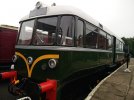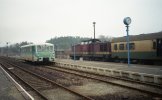Not sure exactly what these railbuses looked like but if we're talking about Germany, there are branch lines which were run, in the 1980s at least, with one-car DMUs which might have been a similar concept.
The Bad Krozingen-Muenstertal branch in the Black Forest was run as such: a (modern, white) one-car DMU during the day, generally as a shuttle with a few main-line extensions to Freiburg in the peaks and also for shopping/sightseeing visits (there was a 10:00 or so through service). The stations were mostly very small and unstaffed halts, but Staufen (the largest town) was bigger and staffed, as was Muenstertal itself, I think. This was run by a local company, SWEG, not DB. (This was 1986 and 1987). There was also an older, antique looking red DMU which ran one service in the peak and had a very loud horn which was guaranteed to wake you up in the morning; the campsite I was staying at was adjacent to the railway.
The sort of line that I'm sure would never have survived in the UK under Beeching. Glad to report it was still running in 2009, though even the more modern 1987 DMU had been replaced by a newer-style DMU (still one-car only though).



